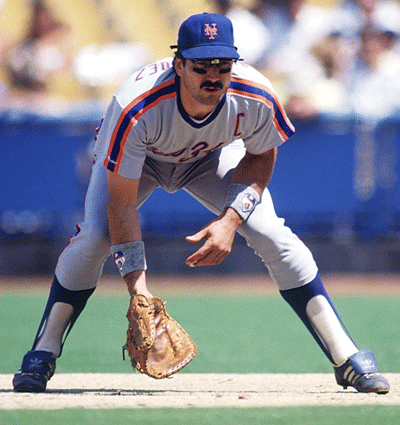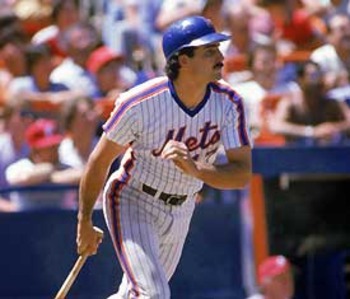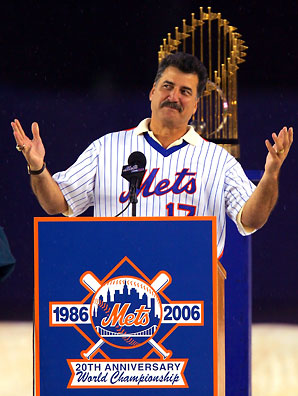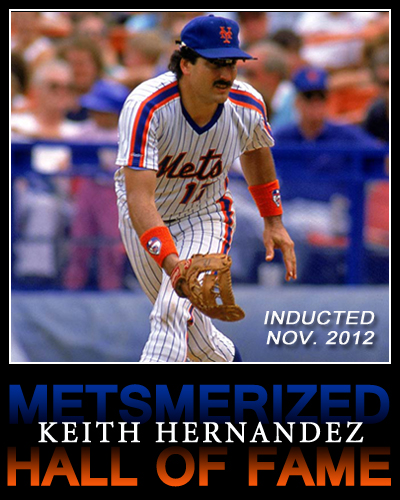Last week Mets Merized Online rolled out our Metsmerized Hall of Fame. We will be enshrining one player each week until our five founding members are all unveiled. Last week, we selected Tom Seaver as our first member. After our five Founding Members are selected, we will ask you, our readers, to cast your ballot for who should be selected for enshrinement in 2013. Learn more by visiting our Metsmerized Hall of Fame.
Keith Hernandez: The Darkness Comes To An End
There are times in our life when we remember exactly where we were and what we were doing. For Mets fans one of those times is June 15, 1977. With one swift move, M. Donald Grant effectively ripped out the heart of this club when he traded away Tom Seaver. The departure of Seaver immediately sent the entire organization into a tailspin. That season the Mets finished last for the first time in a decade, 37 games back. The Mets would remain in the cellar of the NL East for 2 more years after that and 5 of the next 7. Six years after the darkest day in Mets history, we finally saw a light at the end of the tunnel.
When Nelson Doubleday bought the Mets after the 79 season, we were told The Magic is Back. New GM Frank Cashen stated it would take 5 years to rebuild and be competitive. Although attendance improved, the Mets did not. Over the next 3 seasons, our winning percentage was a meek 404.

Half way across the country there was dissension amongst the Cardinals. They were defending World Champions, having defeated Milwaukee in the 1982 World Series. First baseman Keith Hernandez had led St. Louis to a title, knocking in 8 RBI’s in the fall classic. But by the following summer, Keith and Cardinals manager Whitey Herzog were at odds. Herzog questioned Keith’s work ethic, accused him of doing crossword puzzles rather than being involved in the game and called him “a cancer on the club.”
A thousand miles away in Flushing, Frank Cashen picked up the phone.
Cashen knew the Mets had promising stars on the horizon. But he needed a veteran presence to build a winner around. Cashen sent pitchers Neil Allen and Rick Ownbey to St. Louis in exchange for Keith. But the Mets obtained more than just a first baseman. They got a batting champion, former co-MVP and a proven winner. With the acquisition of Mex, the wheels were set in motion. The trade occurred on June 15,1983. Six years to the day after the Seaver trade, the veil of darkness was lifted.
Keith’s contentious relationship with former manager Herzog was the basis for the Mets/Cardinals rivalry throughout the decade.
In St. Louis, Keith had worn #37. Ironically, that was the only number the Mets had retired. He wanted to wear something ending with a ‘7’ as a tribute to his hero and the man he shared a birthday with, Mickey Mantle. Keith elected to go with #17.
The following season, 1984, along with rookie phenoms Darryl Strawberry and Dwight Gooden, Keith’s winning attitude seemed contagious. We won 22 more games, going from 68 wins to 90. The Mets had their first winning season since 1976 and the 90 victories was the 2nd most in club history.
Over the next 4 seasons Keith put up solid respectable stats. He averaged 88 Runs, 174 hits, 32 doubles, 89 RBI’s, batted 305 with an OBP of 396 and slugged at 440. But it was more than just his stats. Keith was a champion. He was one of those rare combinations who was loved by fans, respected by teammates and admired by his opponents.
Intensity. It was written on Keith’s face all the time. Every at-bat, every pitch of every at-bat, Keith approached like it was the bottom of the 9th of a Game 7. In the dugout or on a day off, he was always standing close to Davey Johnson, shadowing him, almost as if he was co-managing.
 In Football, the quarterback is referred to as The Field General. For all intents and purposes, Keith was the Mets ‘Field General.’ It was he, almost more than Gary Carter, who would walk to the mound to calm the nerves of a pitcher. He won 6 consecutive Gold Gloves while with the Mets. He played the game and his position the way it was supposed to be played: With class, with flare.
In Football, the quarterback is referred to as The Field General. For all intents and purposes, Keith was the Mets ‘Field General.’ It was he, almost more than Gary Carter, who would walk to the mound to calm the nerves of a pitcher. He won 6 consecutive Gold Gloves while with the Mets. He played the game and his position the way it was supposed to be played: With class, with flare.
His aggressive defensive prowess literally altered the game. Hal Lanier, manager of the Astros said, “Bunting against the Mets is nearly impossible.” Cubs manager Jim Frey stated, “When you bunt against Hernandez, you’re simply asking for a force out at 2nd and now you’ve got your pitcher running the bases.”
Keith also would take pick-off throws while squatting in foul territory. This allowed him an easier tag on the leg of the baserunner. The move is now illegal.
On bang-bang plays at first base, Keith would sneakily lift his foot from the bag a split second before actually catching the throw, a move perfected by Gil Hodges in the 1950’s.
It was this intensity and style of play, his winning approach to the game itself, which was the reason he became first team captain in Mets history.
Keith was penciled in to the #3 spot for 7 years in New York. However, by 1988, Mex was turning 35 and the years were catching up to him. He battled hamstring problems throughout the summer and played in just 95 games. The following year, 1989, Keith missed nearly 2 months with a fractured kneecap. He played in just 75 games and hit 233. He played one more season in the majors, with Cleveland, before retiring.
During his career, both in New York and St. Louis, Keith batted over 300 6 times. He won two Silver Sluggers, was a five time All-Star. He won eleven consecutive Gold Gloves, the only First Baseman in Baseball History to achieve that.
Keith’s batting average of 297 over seven seasons with the Mets is the third highest in team history, trailing only John Olerud and David Wright. His career 387 OBP is also third highest in team history, behind Olerud and Dave Magadan.
Teammates David Cone (with the Mets) and Ron Darling, Bob Ojeda and Roger McDowell (after they left the Mets) all wore #17 as a tribute to Keith.
Throughout the history of this team, we’ve had countless great and unforgettable moments: Amazin’ catches by outfielders in the post-season, a playoff winning walk-off HR by a reserve catcher, a grand slam single, black cats, a no-hitter tossed by an aging left-hander, a shot to straight away center that healed a city days after the unthinkable happened.
However, in the fifty years the Mets have been part of the Grand Ol’ Game, only a few select moments can be marked as turning points, be it good or bad, in the course of this club. The discarding of Tom Seaver stands as one. Or Tom Terrific’s Imperfect Game in that glorious summer of 1969. The trade that brought us Mike Piazza from Florida.
And yes, the acquisition of Keith Hernandez was also a turning point. When we all think back to the glory days of the 1980’s and the Dynasty that never quite materialized, a smile crosses our collective faces. It all began on June 15, 1983 when Keith put on the blue and orange for the very first time.
It’s with great pleasure that we announce Keith Hernandez as the second player to be enshrined into the…
















